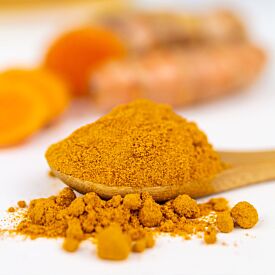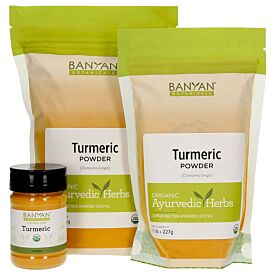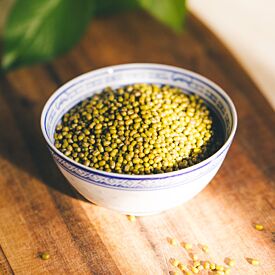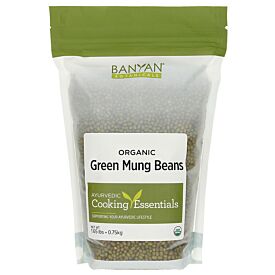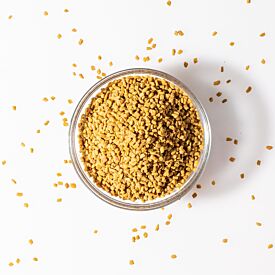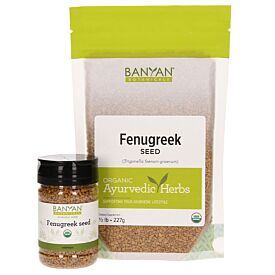Satisfying Kitchari Recipe for Hungry Pitta Bellies
Hearty Green Mung and Black Rice Kitchari
Have you ever gotten “hangry”? If you or someone you’re close to gets that intense ravenous hunger, then you know what I’m talking about. Watch out for those hungry pitta bellies!
I have very sharp hunger, which in Ayurveda is called tikshna agni (sharp or hot digestion). This type is typically found in pitta-predominant constitutions and can sometimes be connected with too much heat and sharpness in the GI tract. This heat and sharpness in turn causes excess intensity in the digestive fire (agni) and can lead to physical and even emotional imbalances.
People with this type of digestion will sometimes have ravenous hunger and an insatiable appetite, and they can crave dense or heavy foods, but they may not realize that their digestion is actually more sensitive than it seems.
Tikshna agni people tend to feel hunger more often than other agni types, so they make the mistake of eating every two hours or snacking every time they are even mildly hungry. Unfortunately, this is one of the most aggravating things you can do to your gut—it can cause long term damage and wreak havoc on your energy levels.
Because I’ve found this to be such a tricky balance for myself and my many students and clients who also have tikshna agni, I’ve spent years trying to figure out the perfect balance that is cooling and soothing, gut healthy, easy to digest, delicious, and hearty enough to keep a ravenous pitta satisfied so they don’t get hungry again in an hour or two.
This search led me to craft a special recipe for a delicious, simple, and satisfying meal that is very healing and cooling for pitta.
As I created it, I kept a few key spice perspectives in mind. The following tips will clarify some of these important fundamentals and help you to think through future pitta-reducing meals you may want to create on your own:
- We need to leave out heating, pitta-spiking spices so we can cool and soothe the gut lining without stimulating excess heat from the already-hot GI tract.
- At the same time, we want to gently support good digestion and absorption of nutrients, and make it taste delicious. For all of this, we will use tasty, cooling herbs and spices.
This recipe is perfect for the end of the summer to release excess heat that builds up during the hot months, or any time of year you want to reset your gut, cool and nourish your body, and upgrade your overall health.
Green Mung and Black Rice Kitchari Recipe
Oddly enough, many pittas LOVE hot, spicy food even though it is not ideal for their constitution. This is a very nourishing and cooling stew that has a very mild pungent spice but specifically omits garlic, onion, ginger, and pepper to help cool the body and give the gut a break!
That being said, some pittas just can’t stand when their hot spices are taken away, so I offer you the option of adding a little pinch of pippali for an extra pungent pop.
Pippali, also known as Indian long pepper, is a milder form of pepper that is less aggravating to pitta than black pepper. Pittas, please use this sparingly, if at all. Try it out first without it—you’ll be pleasantly surprised how flavorful and truly satisfying this dish is!
Ingredients:
- ½ cup whole green mung beans
- ½ cup forbidden black rice (may also sub brown rice)
- 1 tablespoon coconut oil or ghee
- 1 tablespoon fennel seeds
- 1 teaspoon fenugreek seeds
- 1 anise star
- 1 large fennel bulb, diced
- A few handfuls of fresh chopped fennel fronds
- 1–2 cups diced veggies of your choice, such as yam, celery, carrot, zucchini
- Approximately 2 cups filtered or spring water, homemade vegetable broth, or organic bone broth
- 1 teaspoon turmeric powder
- Pink mineral salt to taste
Optional garnishes:
- 1 small handful of chopped fresh herbs such as dill, mint, or cilantro
- Pinch of pippali to taste
- A squeeze of fresh lime
Directions:
Soak whole green mung beans and black rice overnight in cold water. Drain and rinse in the morning.
In a large pot, dice up fennel bulb and fronds and sauté on medium heat in coconut oil or ghee until slightly soft. Move fennel to outer edges of the pot and add fennel seeds and fenugreek seeds to the center in the oil. Sauté until they become lightly browned and fragrant.
Add mung beans, rice, diced veggies, and anise star, and mix together. Add enough water or broth to cover all of the ingredients. Cover, bring to a boil, reduce heat, and simmer just until the veggies turn soft, about 20 minutes.
Stir in turmeric powder, salt, additional chopped herbs and pippali at the very end.
Serve with a squeeze of fresh lime, more chopped green herbs, and salt to taste. Enjoy!
It’s my pleasure to share all of this with you, and I hope you love the recipe!








